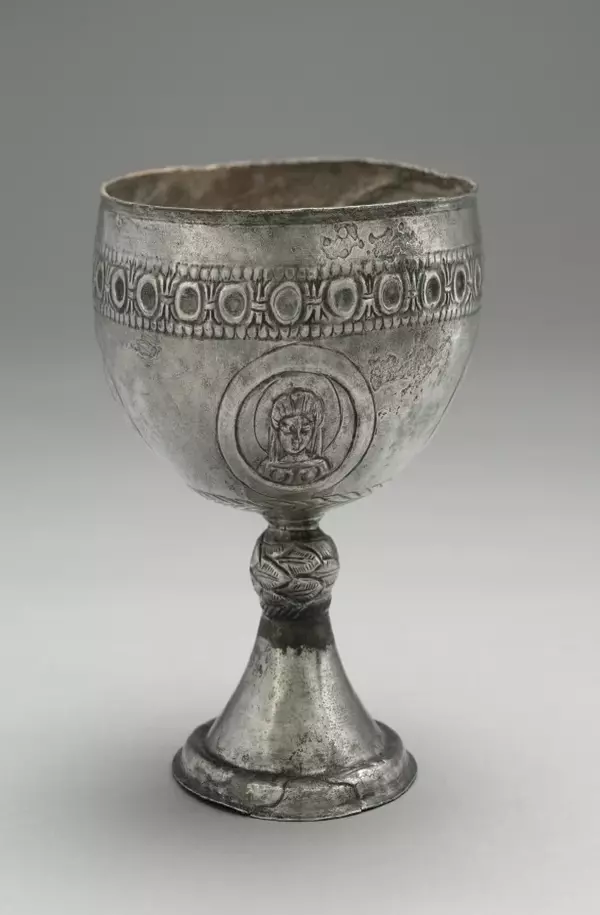Sacred Vessels
Sacred Vessels
What do we see on top of the mensa when we enter a church? There are certain altar linens that all have their specific usages. There are, however, also non-fabric objects; we call them “vessels.” What are these sacred vessels, their histories, and their usage?
Nota Bene: The following is a general description. The usage of these vessels varies not only from denomination to denomination but from church to church and congregation to congregation within a denomination.
Liturgical Vessels of Early Christianity
When the early Christians regularly practiced the Lord’s Supper as part of the worship service after Pentecost, they met secretly in houses or other clandestine places. They used everyday objects to celebrate the Eucharistic feast. A chalice was a vessel that was used daily for drinking at meals. It could be made of gold, silver, bronze, tin, lead, or wood. Ancient coins or mosaics show us that the shape has changed throughout history since the early days of Christianity. The chalice we are familiar with was not the original shape. Sadly, few of the actual objects remain due to the destruction of time.
A place that may be close for some of my readers to travel and see houses a really wonderful and well-preserved collection. The Cleveland Museum possesses four pieces of liturgical vessels dating from circa 500-700 A.D. Archaeologists discovered these in Northern Syria, where early Christians likely buried their precious goods to protect them from the invading Persians or Arabs.
1
 2
2
1“Cleveland Beth Misona Chalice.” Beth Misona Treasure, Cleveland Museum of Art, Cleveland Ohio. Accessed September 1st, 2016. http://www.clevelandart.org/art/1950.380?collection_search_views_fulltext=&created_date_op=%3D&created_date=&between_start=&between_end=&field_artist=&page=20&f[0]=field_collection:836
2“Cleveland Beth Misona Paten.” Beth Misona Treasure, Cleveland Museum of Art, Cleveland Ohio. Accessed September 1st, 2016. http://www.clevelandart.org/art/1950.380?collection_search_views_fulltext=&created_date_op=%3D&created_date=&between_start=&between_end=&field_artist=&page=20&f[0]=field_collection:836
Covering the Eucharistic Vessel
There are three chalices and one paten in this set. These pieces are all silver, and they feature decorations of Saint Peter, Saint Paul, Christ, and the Blessed Virgin on the chalices. The collection was given to a priest named Zeno by Kyriakos son of Domnos. If anyone has seen this beautiful collection, please leave a comment and tell us your thoughts! The Cleveland Museum is now most definitely on the list of places to someday visit.
When we see a chalice being used, it holds the wine during the Communion Service. If the church can afford it, they typically make it from precious metals or stones and cover it with a special veil. In the Roman Catholic Church during a low Mass, the priest will be the one to carry the chalice. It is always covered in a silken material the same color as the liturgical season. During a high Mass, a subdeacon prepares the chalice cup on a credence table and then transports it to the altar under the humeral veil. The humeral veil is like a shawl (long and narrow) worn over someone’s shoulders. The wearer carries the items hidden under the humeral veil to the altar. In other denominations, the chalice remains on the altar, covered by white linen or a chalice veil of the same color as the liturgical season. It is uncovered for communion and then the chalice veil is replaced after that part of the service is concluded.
3Roberts, Carrie. Rose Chalice Veil. June 25th, 2015. Personal Collection, Baxter, Minnesota.
Paten
Most denominations place the paten on their altars as the second common vessel. This small plate has a shallow dip and holds the bread during the Eucharist. The priest or pastor carries this plate-like object as he distributes the bread at communion. Before placing the bread on the paten, someone brings it to the place of consecration from the sacristy in the third vessel, the ciborium. Lesage notes that before recent times–before the 20th century–searching liturgical books for the word “ciborium” was almost pointless. The traditional name associated with this vessel is “pyxides.” This derives from the word the Greeks used for a little box. It was customary for early Christians, monks, or hermits, to store the consecrated Body of Christ in their homes in these small boxes. The priests could be seen carrying the sacrament to the shut-ins in these boxes. These little treasure chests would also be used occasionally in processionals to carry the Host, although more often than not some other sacred object–a reliquary, a crucifix, or inside a statue of the Virgin Mary, John the Baptist, or Christ–was used instead. Traditionally, a bishop consecrates the chalice and paten, whereas the ciborium only receives a blessing.
4Robert Lesage, Vestments and Church Furniture (New York: Hawthorn Books, 1960), 34.
It is important to understand the objects we see being used in every church service. We can create beautiful coverings and embroidery designs, but it is crucial to understand what we are covering and why we place appropriate designs to adorn these covers because what is under them is truly special. For more information on sacred vessels, I recommend the third chapter in Robert Lesage’s book, Vestments, and Church Furniture. Thank you for reading!
~Nihil Sine Deo~
Be sure to visit our online store front Ecclesiastical Sewing where you may shop for Liturgical Fabrics, altar linen fabrics, church vestment-making patterns, liturgical machine embroidery designs, church vestment trims and notions and so much more. You may also find us on Ecclesiastical Sewing on Facebook, Twitter, and Pinterest. Sign up for our mailing list at the bottom of the page on our online store front and receive a free copy of our Small Linens Booklet as our way of saying thank you for following along.
Bibliography
“Byzantium, Syria, 6th-7th Century Chalice From The Beth Misona Treasure.” The Amica Library. Accessed September, 1st, 2016. http://www.davidrumsey.com/amica/amico10101780-34861.html
“Chalice from the Beth Misona Treasure, c. 500-700.” Cleveland Museum of Art. Accessed September 1st, 2016. http://www.clevelandart.org/art/1950.380?collection_search_views_fulltext=&created_date_op=%3D&created_date=&between_start=&between_end=&field_artist=&page=20&f[0]=field_collection:836
Lesage, Robert. Vestments and Church Furniture. New York: Hawthorn Books, 1960.
Rose Chalice Veil Construction
Chalice Veil Orphrey Trim Part 2
Passion Cross on Ash Wednesday Chalice Veil
Making a Chalice Veil Part II: Good Friday Chalice Veil
Sewing a Chalice Veil: Construction Details
Save







 RSS - Posts
RSS - Posts
You must be logged in to post a comment.